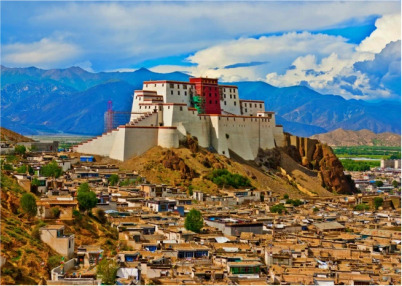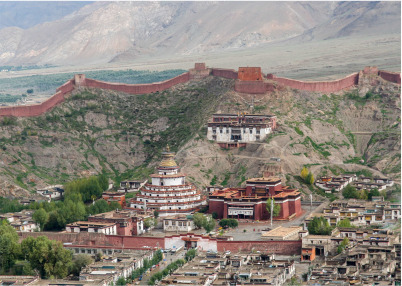Tibet Discovery
- 06 Nights/07Days
- tibet
- Lhasa – Gyantse – Shigatse – Lhasa
About the Tour
This tour will show you most of the real highlights of Tibet, landscape, snow capes mountains, Lakes, monasteries and its ancients architecture. We together visit Potala Palace, Jokhang Temple, Norbulingka Palace, Sera Monastery, Barkhor squire in Lhasa. Visit Gyantse Zhong in Gyantse and next visit of second biggest monastery Tashilampo in Shigatse. Driving in the well-paved road with the highest pass of Karo La (5010m) with the panoramic view of the Tibetan Himalayas. Another attraction of biggest Yamdrok Lake from on the way driving Lhasa to Gyantse.
Highlights
- Visit Potala Palace and Jokhang Monastery
- Explore Drak Yerpa - spiritual axis’s of Lhasa
- Visit sacred Buddhist temples and monasteries
- Pride of Gyantse “Gyantse Dzong and Kumbum”
- Go to discover the sacred lake as well as one of the most scenic lakes in Tibet
Day 1: Lhasa Arrival
Welcome to the roof of the world You will be picked up by a local tour guide at the airport hall or train station, and then be escorted to your hotel in Lhasa city in a private vehicle. After arrival at your hotel, the rest of the day is free for you to explore the local areas and acclimatize yourself to the air, temperature and high altitude of Lhasa.
High Altitude Acclimation Tips: 1) go for some leisure walking to acclimate the high altitude but avoid strenuous activity after arrival; 2) you’d better not have a bath, in case of catching a cold; 3) drink more water, and have some fruit; 4) have a good rest.
Day 2: Lhasa ( B )
Start today’s Lhasa exploration with an exciting visit to the landmark - Potala Palace which is regarded as one of the most beautiful architectural buildings in the world. You will climb up the palace along the zigzag stone paths with white-and-red walls to the top of the palace where you can not only appreciate the exotic Tibetan-style architecture, but also get a great view of Lhasa’s urban areas, then walk into the inner space of Potala Palace to explore the stately chapels and learn about the history of the palace.
Continuing your exploration, you will then get to Jokhang Temple which is considered as the spiritual heart of Tibetan Buddhism. Each day, there are thousands of pilgrims coming from different places in Tibet to the temple to worship the Buddha. This temple is also known as the “house of Buddha” because it keeps the precious Jowo Rinpoche, the life-sized (5 foot/1.5m) image of the Shakyamuni at the age of 12. The last site for today’s exploration is the famous Barkhor Street. It is a circular and wide street encircling the Jokhang Temple. The local people like to walk on the street for several circles usually in the late afternoon as a daily tradition of pilgrimage. The street also has many shops selling a wide variety of traditional Tibetan goods, religious items, and handcrafts.
Tips of Today: 1) there are 1,080 steps up to climb to the top of Potala Palace, so don’t walk in a rush, which may cause high altitude sickness; 2) taking photos is not allowed inside the palace; 3) today you will be mainly outside, please bring some water, a hat, sun cream, and sunglasses with you. Can't-be-missed Potala Palace in Tibet
Day 3: Lhasa ( B )
After breakfast, you will firstly go to visit the beautiful Norbulingka which used to be the former summer palace of Dalai Lamas in ancient times and now is a public park. It is famous for its Potrang, the private palaces of former Dalai lamas with grandiose Tibetan architecture style. Next, drive several kilometers to the western outskirts of Lhasa to visit Drepung Monastery. Drepung, in Tibetan, means “prosperity”. Since its establishment, Drepung Monastery has always been one of the most important Buddhist monasteries in Tibet. In its heyday, there were more than 10,000 monks lived and studied in the monastery. Throughout its history, many important and famous Tibetan leaders used to study here, especially the Dalai Lamas. So Drepung Monastery is also respectfully known as the “Mother School of Dalai Lamas”.
In the afternoon, you will be taken to another famous monastery in Lhasa - Sera Monastery. It is famous for the spectacular “Buddhism Debating”. As a daily routine, the monks gather in a courtyard and debate on the Buddhist doctrines with supplemented gestures, which is thought to be helpful to facilitate better comprehension of the Buddhist philosophy to attain higher levels of study. After enjoying the "Buddhism Debating", you will be transferred back to the city. The rest time is your own free time to rest.
The Etiquette of Visiting Monastery: 1) you shouldn’t wear short and uncover shoulders; 2) taking off your sunglasses and hat before entering the chapels; 3) taking photos is usually not allowed inside the chapels. Courtyard for Buddhism Debating in Sera Monastery.
Day 4: Lhasa – Gyantse ( B )
Today you will leave Lhasa and drive about 6.5 hours to Gyantse. The first site you will reach is the holy Yamdrok Lake. As the largest fresh lake in the north of the Himalaya Mountains, it spreads about 675 square meters from south to north, like an eardrop lying in the arms of snow-capped giant mountains. Viewing from a distance, you can see fertile pastures full of yaks and sheep, and some small Tibetan villages along the lakeshore. Keeping driving not so far from Yamdrok Lake, you will see the imposing Karola Glacier towering aloft on the right side of the road.
Continuing your trip, you will get to the historical city of Gyantse. Feel hungry? Have a good lunch in the town, then go to visit the mysterious Palcho Monastery. The monks and tradition of three important sects of Tibetan Buddhism - Sakyapa, Zhalupa and Gelukpa, peacefully coexist in this monastery. Its Kumbum, which is 35 meters high and has 76 small chapels with hundreds of images of Kriyatantras, is believed to be the largest such structure in Tibet. Finishing the visit to Palcho, go to take some photos of the Gyantse Dzong Fortress on which the Tibetan army used to fight against the British army's invasion during the early 20th century. It is a very impressive fortress with typical Tibetan palace architecture style which is inherited from Yumbulagang Palace - The First Palace of Tibet. (Gyantse Dzong Fortress now is closed for maintenance. Tourists cannot climb up to the top, but still can enjoy its magnificent appearance from the square at the foot of the Dzong Hill.)
Tips of today: 1) wear warm clothes to prevent cold and wild; 2) the road condition from Lhasa to Gyantse via Yamdrok Lake is good; 3 feel free to ask your driver to stop so you can stretch your legs or take some pictures. Yamdrok Lake is as beautiful as a sapphire.
Day 5: Gyantse – Shigatse ( B )
After breakfast, you will visit a very special site where you can learn about the living condition and traditions of old Tibet -Pala Manor. Located in a Tibetan village about 4km southwest from Gyantse city, Pala Manor is the only aristocratic manor preserved well in Tibet and used to be the private manor of Pala families since the 17th century. The aristocratic and the serfs both lived in the manor but completely different life. The aristocratic didn't need to work, lived in bright, large and luxury rooms, used costly furniture and imported luxuries, such as OMEGA watch, LV purse, wine, etc. While the serfs lived in dark crude room in yards, they got paid little but did all the laboring works. Fortunately, the house, relics in the rooms still remain the same as they used to be.
After the visit to Pala Manor, drive about 2.5 hours to Shigatse. After lunch, you will take a visit to the official seat of Panchen Lama -Tashilhunpo Monastery, which is also the largest and most influential Gelug Monastery in Shigatse prefecture. Here you will see a giant statue of Future Buddha, the largest one of its kind on earth ( 26.2 meters high and 11.5 meters wide ), decorated with precious pearls, turquoises, corals and ambers. Accommodate in Shigatse City.
Tip of today: 1) the road condition is fairly good; 2) obey Buddhist manners and talk appropriately when visiting Tashilhunpo. Tashilumpo Monastery in Thangka Sunning Festival.
Day 6: Shigatse – Lhasa ( B, D )
Today you’ll drive back to Lhasa (5 hours) along the legendary Yaluzangbu River, the mother river of Tibet. On the halfway, you will take a visit to Nyemo Tunba which was the home of Tunmi Sangbuzha who invented the Tibetan character as well as the famous Tibetan Incense. Here in Tunba, you also have the chance to witness the process of making Tibetan Incense with a water mill. At the same time, the scenery here is fabulous - ancient cypress trees, green willows, murmuring river.
Leave Tunba, keep driving to Lhasa. In the evening, you’ll have a Tibetan-style farewell dinner in a typical Tibetan restaurant, with traditional Tibetan songs and dances. A worker is making Tibetan Incense.
Day 7: Lhasa Departure ( B )
Today is free for you until your tour guide transfers you to the airport in time for your flight or drop you off at Lhasa train station.
Tips of Today: 1) please pack your luggage carefully, especially for small things like camera charger, power adaptor, mobile phone, phone charger, wallet, and towel; 2) If your flight is arranged in the afternoon, please make sure you check out the hotel before 12pm.
Inclusions
- Accommodation on Single / Twin / Double sharing basis in offered hotels or similar.
- Daily breakfast at the hotel
- All transfers and excursions will be covered by air-conditioned vehicle.
- Tibet entrance permit and visa
- One shared big Oxygen tank in the car.
- Complimentary Mineral water bottle during your tour is provided in the car.
- Services of Local English Speaking Guide for sightseeing.
- Currently applicable taxes.
Exclusions
- Airfare / Train fare
- Camera charges at any monument to be paid by the guest directly
- Any insurance
- Tips for the guide, and porter.
- Expenses of personal nature like liquor, laundry, tips, telephone, fax, internet, etc.
- And anything not mentioned in Inclusions.
Tour Notes
- Rates are subject to availability
- Room category in all packages are the base category rooms
- The above rates are not applicable from 20th Dec'2019 to 10th Jan'2020.
- Christmas & New Year gala charges are on a direct pay basis at the hotel by guest.
- In case we are not able to provide the same hotels as mentioned, then we shall provide similar alternate properties, change in the cost if any will be advised.




